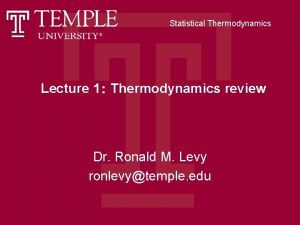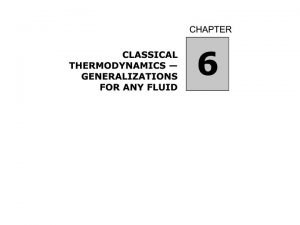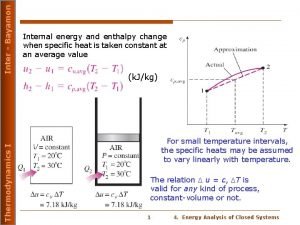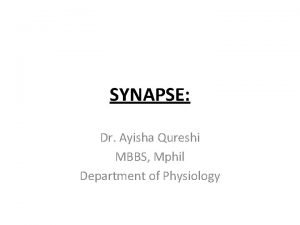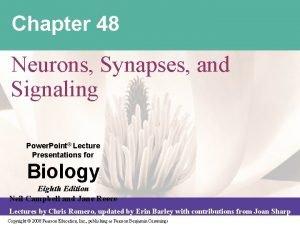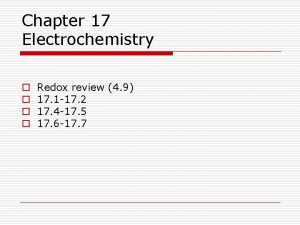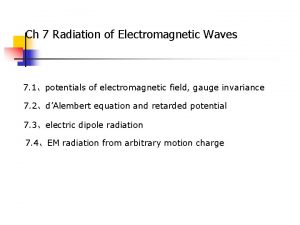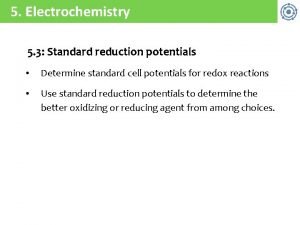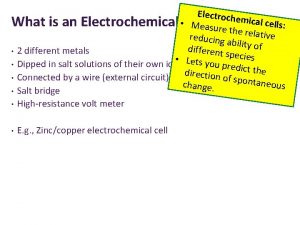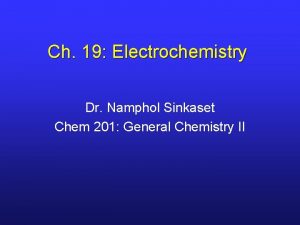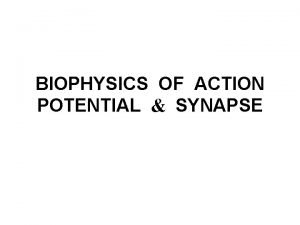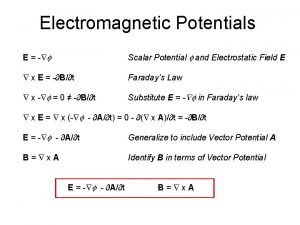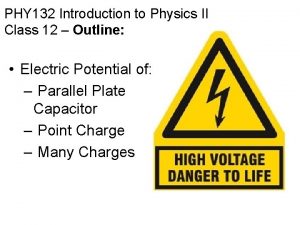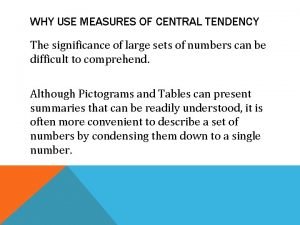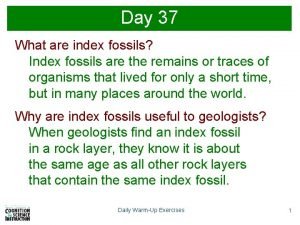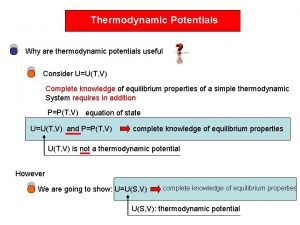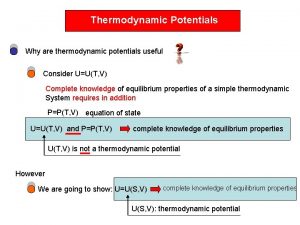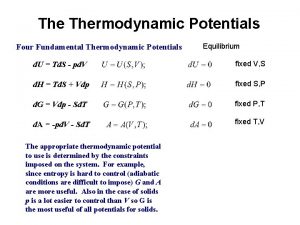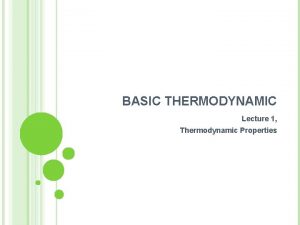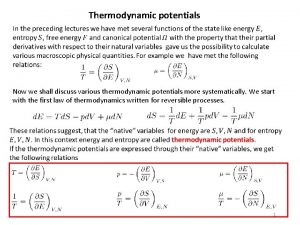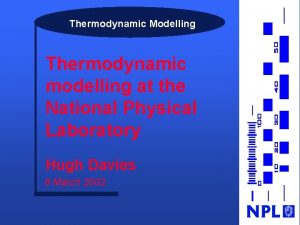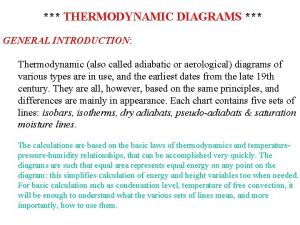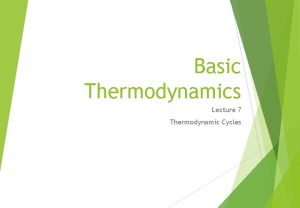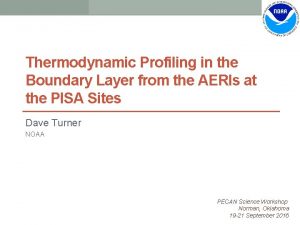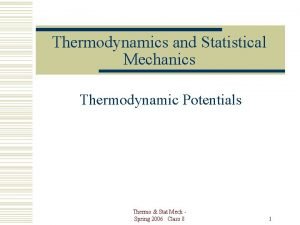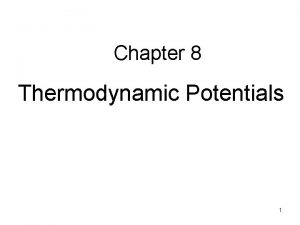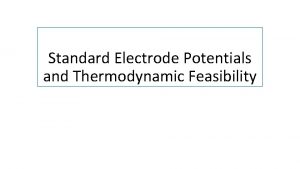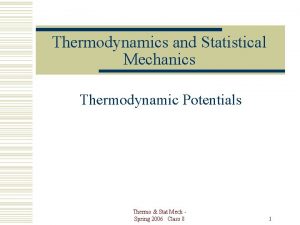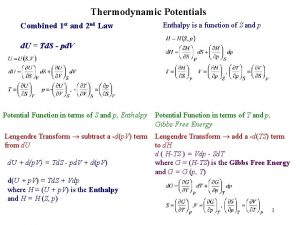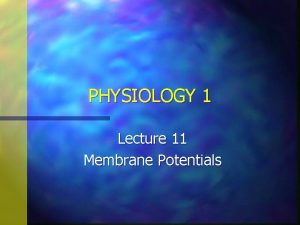Thermodynamic Potentials Why are thermodynamic potentials useful Consider






















- Slides: 22

Thermodynamic Potentials Why are thermodynamic potentials useful Consider U=U(T, V) Complete knowledge of equilibrium properties of a simple thermodynamic System requires in addition P=P(T, V) equation of state U=U(T, V) and P=P(T, V) complete knowledge of equilibrium properties U(T, V) is not a thermodynamic potential However We are going to show: U=U(S, V) complete knowledge of equilibrium properties U(S, V): thermodynamic potential

The thermodynamic potential U=U(S, V) 2 nd law Consider first law in differential notation inexact differentials expressed by exact differentials Note: exact refers here to the coordinate differentials d. S and d. V. T d. S and Pd. V are inexact as we showed previously. Legendre Transformations d. U: differential of the function U=U(S, V) natural coordinates

Legendre transformation Special type of coordinate transformation Partial derivatives of U(S, V) (vector field components) Example: coordinates Legendre transformation: One (or more) of the natural coordinates becomes a vector field component while the associated coefficient becomes new coordinate. Click for graphic example Back to our example becomes a coordinate becomes a coefficient in front of d. P

Product rule easy check: =: H (enthalpy) Enthalpy H=H(S, P) is a thermodynamic potential

Geometrical interpretation of the Legendre transformation - 1 -dimensional example Note: natural variable of f is Y’ Legendre transformation: Y and X have to be expressed as Y=Y(Y’) and x=x(Y’) mapping between the graph of the function and the family of tangents of the graph

Legendre transformation (T, V): from (S, V) Helmholtz free energy to (T, P): Gibbs free energy

equilibrium thermodynamics and potentials thermodynamics potential complete knowledge of equilibrium properties Consider Helmholtz free energy F=F(T, V) Differential reads: and Entropy Equation of state Response functions from 2 nd derivatives and etc.

Maxwell relations differential of the function F=F(T, V) d. F is an exact differential In general: relations which follow from the exactness of the differentials of thermodynamic potentials are called Maxwell relations

Properties of an ideal gas derived from the Helmholtz free energy F=U-TS Reminder: Equation of state:

S(T, V) obtained from U=F+TS Heat capacity at constant volume Note: U derived from F Isothermal bulk modulus Equation of state derived from F etc.

Systems in Contact with Reservoirs Entropy statement of 2 nd law: entropy always increased in an adiabatically isolated system What can we say about evolution of systems which are not adiabatically isolated Consider system at constant temperature and pressure adiabatic wall changes from initial state with System to final state with T=const. Heat Reservoir R remain constant

Entropy change of : From Aim: Find the total entropy change Entropy change and apply 2 nd law of the reservoir: Heat reservoir: T=const. With 1 st law: Heat QR that, e. g. , leaves the reservoir flows into the system Q = -QR

Entropy statement of 2 nd law: for an adiabatically isolated system (T=const, P=const. ) Gibbs free energy never increases in a process at fixed pressure in a system in contact with a heat reservoir. Gibbs free energy will decrease if it can, since in doing so it causes the total entropy to increase. System with V=const. in contact with a heat reservoir Special case, very important for problems in solid state physics Q = -QR (T=const, V=const. )

Summary: Thermodynamic potentials for PVT systems Potential Internal energy U(S, V) Enthalpy H(S, P) H=U+PV Helmholtz free energy F(T, V) F=U -TS Gibbs free energy G(T, P) G=U –TS+PV differential d. U=Td. S-Pd. V d. H=Td. S+Vd. P d. F=-Sd. T-Pd. V d. G=-Sd. T+Vd. P 1 st law: Isobaric process Vector field components Maxwell relations Properties T=const, V=const T=const, P=const

Open Systems and Chemical Potentials Open system Particle exchange with the surrounding allowed Particle reservoir T=const. Heat Reservoir R Thermodynamic potentials depend on variable particle number N Example: U=U(S, V, N)

U(2 S, 2 V, 2 N) = 2 U(S, V, N) In general: (homogeneous function of first order) S holds and in particular for =1 V N

keep N constant as in closed systems Chemical potential

Intuitive meaning of the chemical potential μ First law: mechanical work Pd. V + with work μd. N required to change # of particles by d. N How do the other potentials change when particle exchange is allowed Helmholtz free energy F=U-TS

F Gibbs free energy G=U -TS+PV Properties of μ With and both extensive intensive (independent of N)

Equilibrium Conditions Adiabatically isolating rigid wall System 1: T 1, P 1, 1 From differentials of entropy changes System 2: T 2, P 2, 2

Total entropy change 2 nd law In equilibrium With conservation of -total internal energy -total volume -total # of particles

small changes d. U 1, d. V 1, d. N 1 0 0 0 Equilibrium conditions T 1 = T 2 Remark: T 1 = T 2 , P 1 = P 2 , 1 = 2 and 1 = 2 no new information for system in a single phase but Important information if system separated into several phases (see next chapter)
 Insidan region jh
Insidan region jh U=ts-pv
U=ts-pv Maxwell relation
Maxwell relation Thermodynamic square
Thermodynamic square Inter bayamon
Inter bayamon Hey bye bye
Hey bye bye Postsynaptic potentials
Postsynaptic potentials Source of bioelectric potential is dash in nature
Source of bioelectric potential is dash in nature Graded potential vs action potential
Graded potential vs action potential Graded potential
Graded potential Postsynaptic potentials
Postsynaptic potentials Standard reduction potential table
Standard reduction potential table Lienard-wiechert potentials
Lienard-wiechert potentials Cathode anode standard reduction potential
Cathode anode standard reduction potential Eθcell
Eθcell Use the tabulated half-cell potentials to calculate
Use the tabulated half-cell potentials to calculate What are electrical synapses
What are electrical synapses What is scalar potential
What is scalar potential An electron follows the trajectory shown from i to f
An electron follows the trajectory shown from i to f Dont ask
Dont ask Why is the median useful
Why is the median useful Whats an index fossil
Whats an index fossil Why is mass more useful than weight for measuring matter
Why is mass more useful than weight for measuring matter


